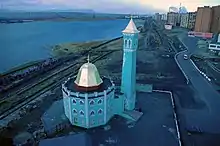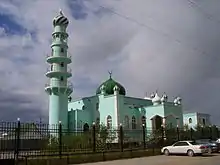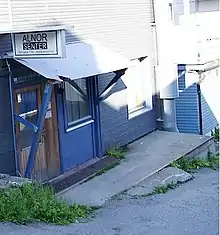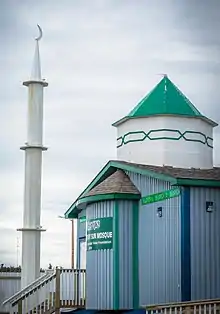Islam in the Arctic
The history of Islam in the Arctic starts relatively late in the chronology of Islamic history, the Arctic Circle being at a great distance from traditional Muslim bastions of power and settlement. The "climatic conditions, remoteness and heavy industrial character" of northern cities have resulted in a unique cultural shift for Muslims living in the region,[2] including a tendency towards pluralism wherein sects like Sunni and Shia Muslims do not segregate themselves.[2] In areas where the midnight sun renders the five daily prayers impossible to tie to dusk and dawn, congregants typically either use the same timing as a more southern region, the holy city of Mecca or their homelands.[3]
General Arctic issues
The Egyptian professor M. G. El-Fandy has opined that the Quranic ayat in Surah al-Kahf that references Dhu al-Qarnayn's reaching of the land where the sun resided after setting was likely a miraculous reference to the Arctic Circle.[4]
In 2018, a delegation from the United Arab Emirates accompanied Adnan Amin, the Director-General of the International Renewable Energy Agency based in Abu-Dhabi, to the fifth Arctic Circle Assembly in Reykjavík, Iceland.[5] Ziad Reslan of the Kennedy School of Government and Marwa Maziad of Arctic Studies at the University of Washington noted the Arab World and the Arctic have a natural connection, given the importance of energy income management operating in rentier states, and that the refugee crisis overlaps with a need for increased migrant workers in the far north.[5]
Russia

A study from 2019 described Muslim communities in Arctic Russia as "rapidly growing" in the last two decades. An early attempt to build a mosque in a major city (Yakutsk, about 450 kilometers (280 mi) south of the Arctic Circle) failed upon the outbreak of the First World War and the following October Revolution. In 1996, however, it became the site of the world's largest mosque in the far north, capable of holding 3000 worshipers.[2]
Siberian Mullahs since the 19th century were hesitant to recognise distant authority.[2] After the 1991 Collapse of the Soviet Union, three central Muslim directorates competed for control of the Islamic population in Siberia, the far East and the far North; one of these three was absorbed into another, leaving the CDUMR and the Council of Muftis—the latter seen as closely tied to the Russian government.[2] In 1998, the first mosque was built for the industrial city of Norilsk, and by 2007 the Muslims in the city were estimated at 20% of the population, coming from Dagestan, Central Asia and Azerbaijan.[7]
Nearly every Arctic city in Russia has a Muslim presence as of 2019, and the 59 mosques and musallas spread across the Arctic exist in every region except for the Nenets Autonomous Okrug and Chukotka.[2] A periodical journal named Islam in Yakutia is printed in Neryungri.[2] In 2014, it was noted that a large number of ethnic Russians in Tyumen, which boasts 30 northern mosques, seemed to be converting to Islam.[8]
Challenges to the Muslim presence are of different kinds. The Arctic city of Vorkuta had a strong skinhead and white nationalist scene in the 1990s and 2000s, and a Russian nationalist group protested against the mosque there.[2] The Yamal Peninsula has a meat processing business run by Nyda-Resurs of halal reindeer meat, which struggles against more traditional meats like mutton.[2] In addition, the two Muslim organizations compete with each other over control of new Muslim communities; their competition is ideological (with the Council of Muftis more vocally supporting rights of Russian Muslims), political (since the council is closely connected to Moscow, and sometimes denounced as a state-backed organization that seeks to extend Moscow's control over Russia's Muslims), and ethnic (since North Caucasians dominate the council, while Tatars and Bashkirs traditionally control the CDUMR).[2]

Percentage of Muslims in Russian Arctic regions:[9]
| Region | Percentage of Muslims |
|---|---|
| 0.00 | |
| 0.00 | |
| 1.25 | |
| 1.20 | |
| 1.13 | |
| 1.00 | |
| 1.50 | |
| 1.00 | |
| 1.00 | |
| 0.00 | |
| 0.40 | |
| 5.75 | |
| 1.40 | |
State of Alaska

The Muslims of the Americas have a property in Alaska which has drawn criticism, although they have explained their interests are in organic farming, communal living and raising organic meat.[10] The Islamic Community Center of Anchorage Alaska was the first purpose-built mosque in the US state, with construction beginning in 2010 to replace the musalla in a strip mall that had previously served the 3000 Muslim residents.[11][12] A parishioner interviewed by VICE News explained he had chosen Alaska because while applying to immigrate to the United States as a doctor, it was easier if settlement plans were in an under-staffed community in need of doctors.[13] The 35 Muslims of Fairbanks, Alaska, converted the old North Post Chapel into a prayer hall.[14]
Canadian Arctic
In 1905, Ali Abouchadi entered the Yukon Gold Rush alongside his uncle and a friend, the trio having emigrated from Lebanon to partake in the fortune-finding in the Canadian north, although they never made it further north than Lac La Biche, Alberta,--but this caused a "gradual immigration of Lebanese Muslims to Lac La Biche".[15] Twenty years later, Ali alone travelled northward to the Arctic Ocean as a merchant, stopping in Aklavik, but ultimately returning to Alberta.[15]
After the First World War, the Lebanese Muslim Peter Baker started a successful business transiting supplies north from Edmonton to the Mackenzie River to outfit the oil prospectors in the area alongside John Morie.[16] His close relations with the indigenous tribes in the Arctic (he had learned to speak Dogrib and Slavey) irritated his competitors.[16] When the indigenous tribes were largely given the right to vote in 1960, one of their first elections catapulted Baker to the status of Member of Legislative Assembly for the riding of Mackenzie North in 1964, and it is suggested that he was the one to propose Yellowknife as the capital of the territory.[16]
The first mass immigration of Muslims into the Northwest Territories followed the 1970s boom in Arctic petroleum exploration.[17] By 1995, there were five Muslim families living in Inuvik.[17] The first Western mosque in the Arctic was the Midnight Sun Mosque built in 2010 for the city's 100 Muslims; it was assembled further south in Manitoba by the Zubaidah Tallab Foundation (ZTF) and shipped to the Arctic to reduce costs.[17][18][19] Amier Suliman remarked that "this [the mosque] is the first minaret to be erected in the Arctic ...some will say it's a new frontier for Islam."[1] Once in Inuvik, it was attached to a 10-metre (33 ft) minaret which had been locally built.[20] It replaced the aging trailer that had previously served as a Musallah, and was only big enough for twenty people.[17] Following the completion of the mosque, the Muslim Welfare Centre in Toronto provided the funds to purchase an adjacent property to set up the "Arctic Food Bank". It distributes groceries to the town's population, and is now Inuvik's largest charity.[21] The territorial capital of Yellowknife has approximately 300 Muslims.[18]
The Iqaluit Masjid was built, again by the ZTF, in 2015 to serve 80 Muslims in the city of 7000 in Nunavut.[22][18] In 2018, it opened a franchise of the same "Arctic Food Bank" established earlier in Inuvik.[21]
In 2018, a trucking warehouse in Whitehorse, Yukon, was converted into a mosque chiefly by cabinetmaker Fathallah Farajat, from the southern city of Hamilton, Ontario.[23] The opening of the mosque, which was constructed with a financial contribution from the ZTF,[24] marked the first time that there was a Muslim prayer hall in every Canadian province and territory.[23] Hussein Guisti, who had overseen the ZTF's construction of the two earlier northern mosques, dubbed the silver-clad mosque "the Star Trek mosque", in reference to Canadian Muslims' efforts to bring Islam to the frontiers.[23] In 2019, the property was demolished to provide the space for building a new, larger mosque that will contain a library and an Islamic school.[25][26]
European Arctic

At the outset of the 20th century, Finland was the only country in Northern Europe to have a native Muslim population, with approximately a thousand Finnish Tatars.[27] The Vepsians in Finland were among the northernmost peoples with whom Muslim merchants had contacts in the early centuries of Islam - as Azeri merchants traded swords in exchange for animal pelts.[28] In 2018, a study of Finland's Muslims living inside the Arctic Circle found Palestinian, Iraqi, Persian, Turkish, Bengali, Somali, Pakistani and Afghan immigrants - virtually all of whom practiced Sunni Islam.[29]
The first Muslim immigrants to the Arctic regions of the Nordic countries was prior to 1976, when labor migrants including Muslims from Yugoslavia, Pakistan, and Turkey travelled north to find work.[30]
Norway's largest Arctic mosque is in Tromsø, built in 2006 by a convert to Islam and financed by a donation from an anonymous Saudi businessman.[31][3] There are two mosques further north in Alta and Hammerfest.[3]
As of 2013, the only known Muslim living in Greenland is a Lebanese citizen who operates a restaurant in Nuuk.[32]
References
- "Canadian Muslims erect first mosque in Arctic". Egypt Independent. 28 October 2010. Retrieved 30 July 2020.
- Laruelle, Marlene; Hohmann, Sophie (August 2019). "Polar Islam: Muslim Communities in Russia's Arctic Cities". Problems of Post-Communism: 1–11. doi:10.1080/10758216.2019.1616565.
- Salazar, Fortunato (17 October 2019). "A mosque in the land of midnight sun". BBC. Retrieved 30 July 2020.
- El-Fandy, M. G. (1992). Islam and Science. 6. Egypt: Ministry of Waqfs; Supreme Council for Islamic Affairs. p. 33. Retrieved 30 July 2020.
- DeGeorge, Krestia (16 March 2018). "A lonely Arab at the Arctic Circle Assembly".
- "Arctic mosque stays open but Muslim numbers shrink". 15 April 2007 – via Reuters.
- Paxton, Robin (15 April 2007). "Arctic mosque stays open but Muslim numbers shrink". Reuters. Retrieved 30 July 2020.
- Laruelle, Marlene (2 August 2016). New Mobilities and Social Changes in Russia's Arctic Regions. Routledge. ISBN 9781138191471.
- http://sreda.org/maps/arena_russia_main/arena_statistic.xls
- Theriault Boots, Michelle (7 December 2016). "After a Facebook post by an elected official, an Alaska Muslim finds he has to explain his faith". Anchorage Daily News. Retrieved 31 July 2020.
- "Mosque milestone for Alaska's Muslims". Al Jazeera. 25 December 2010. Retrieved 5 August 2020.
- O'Malley, Julia (5 December 2014). "Alaskan Muslims raising the roof of states first mosque". america.aljazeera.com. Retrieved 30 July 2020.
- Park, Dylan (10 September 2016). "The FBI Investigated My Visit to Alaska's First Mosque". Vice. Retrieved 30 July 2020.
- Rinear Bethune, Cynthia. "Practicing Islam in Fairbanks". www.islamawareness.net. Retrieved 30 July 2020.
- Abouchadi, Meet Ali; says, the trailblazing Canadian Muslim (9 May 2017). "Meet Ali Abouchadi, the trailblazing Canadian Muslim". Retrieved 30 July 2020.
- Munir, Hassam (20 October 2019). "'Jew' or 'Black Turk'? The Story of the First Muslim Elected in Canada". Retrieved 30 July 2020.
- Guisti, Hussain. "Western Hemisphere's most northern mosque sent to Canadian Arctic". Manitoba Islamic Association. Manitoba Islamic Association. Retrieved 30 July 2020.
- Kassam, Ashifa (3 July 2016). "Arctic Ramadan: fasting in land of midnight sun comes with a challenge". The Guardian. Retrieved 30 July 2020 – via www.theguardian.com.
- Varga, Peter (23 July 2014). "Nunavut's first mosque to start construction this summer in Iqaluit". Nunatsiaq News. Retrieved 30 July 2020.
- "New polar mosque". Above and Beyond: Canada's Arctic Journal. 5 May 2011. Retrieved 30 July 2020.
- "Immigration, Refugees and Citizenship Canada - Immigration Matters - Tackling food insecurity in Canada's North". Government of Canada. 1 August 2019. Retrieved 30 July 2020.
- Rogers, Sarah (17 May 2019). "Iqaluit Muslims celebrate the holy month". Nunatsiaq News. Retrieved 30 July 2020.
- "Yukon's 1st mosque a milestone for Canada, founders say". CBC News. 29 September 2018. Retrieved 30 July 2020.
- Croft, Dave (16 January 2017). "Growing Muslim community looks to build Yukon's first mosque". CBC News. Retrieved 11 August 2020.
- "New Islamic Centre of Yellowknife Project". www.icyk.org. Islamic Centre of Yellowknife. Retrieved 30 July 2020.
- Peacock, Emelie (11 June 2019). "Yk Islamic Centre torn down, making room for $2.2-million build". MyYellowknifeNow. Retrieved 30 July 2020.
- Eidemiller, K. Yu (1 July 2019). Spatial analysis of Muslim communities' convergence in the Nordic European region, in Scandinavian countries. IOP Conference Series: Earth and Environmental Science. 302 (1). E. E. Krasnozhenova, E. A. Samylovskaya and R.-E. A. Kudryavtseva. doi:10.1088/1755-1315/302/1/012073/meta. Retrieved 31 July 2020.
- Smithsonian Institute, "Studies in Muslim Iconography", 1950. Pg 128
- Yeasmin, Nafisa (1 December 2017). "Cultural Identities in Sustaining Religious Communities in the Arctic Region: An Ethnographic Analysis of Religiosity from the Northern Viewpoint". Journal of Ethnology and Folkloristics. 11 (2): 51–67. doi:10.1515/jef-2017-0013. S2CID 158363008. Retrieved 31 July 2020 – via content.sciendo.com.
- Kulik, S. V. (2019). Islamic diffusion in the countries of the Arctic region: the processes of Muslim migration to Scandinavian countries in the context of the transforming Islamic world. 4th International Scientific Conference "Arctic: History and Modernity" - IOP Publishing - IOP Conf. Series: Earth and Environmental Science 302 (2019) 012070. K. Yu Eidemiller, R. R. Biktimirova, M. N. Vanicheva. doi:10.1088/1755-1315. Retrieved 30 July 2020.
- "Saudi funds first mosque in Norway's North Pole". العربية. 7 December 2008. Retrieved 30 July 2020.
- Malcolm (11 August 2013). "Greenland's sole Muslim resident fasts 21 hours". IceNews News from the Nordics. Retrieved 26 January 2020.

